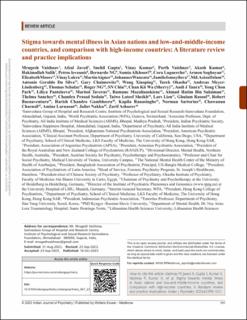Stigma towards mental illness in Asian nations and low-and-middle-income countries, and comparison with high-income countries: A literature review and practice implications
| dc.contributor.author | Vaishnav, Mrugesh | |
| dc.contributor.author | Javed, Afzal | |
| dc.contributor.author | Gupta, Snehil | |
| dc.contributor.author | Kumar, Vinay | |
| dc.contributor.author | Vaishnav, Parth | |
| dc.contributor.author | Kumar, Akash | |
| dc.contributor.author | Salih, Hakimullah | |
| dc.contributor.author | Levounis, Petros | |
| dc.contributor.author | Bernardo, N. | |
| dc.contributor.author | Alkhoori, Samia | |
| dc.contributor.author | Luguercho, Cora | |
| dc.contributor.author | Soghoyan, Armen | |
| dc.contributor.author | Moore, Elizabeth | |
| dc.contributor.author | Lakra, Vanay | |
| dc.contributor.author | Aigner, Martin | |
| dc.contributor.author | Wancata, Johannes | |
| dc.contributor.author | Ismayilova, Jamila | |
| dc.contributor.author | Islam, Md | |
| dc.contributor.author | Da Silva, Antonio | |
| dc.contributor.author | Chaimowitz, Gary | |
| dc.contributor.author | Xiaoping, Wang | |
| dc.contributor.author | Okasha, Tarek | |
| dc.contributor.author | Meyer-Lindenberg, Andreas | |
| dc.contributor.author | Schulze, Thomas | |
| dc.contributor.author | Ng, Roger | |
| dc.contributor.author | Chiu, S. | |
| dc.contributor.author | Wa (sherry), Chan | |
| dc.contributor.author | Tanra, Andi | |
| dc.contributor.author | Park, Yong | |
| dc.contributor.author | Panteleeva, Liliya | |
| dc.contributor.author | Taveras, Marisol | |
| dc.contributor.author | Mazaliauskiene, Ramune | |
| dc.contributor.author | Bin Sulaiman, Ahmad | |
| dc.contributor.author | Sanchez, Thelma | |
| dc.contributor.author | Sedain, Chandra | |
| dc.contributor.author | Sheikh, Taiwo | |
| dc.contributor.author | Lien, Lars | |
| dc.contributor.author | Rasool, Ghulam | |
| dc.contributor.author | Buenaventura, Robert | |
| dc.contributor.author | Gambheera, Harish | |
| dc.contributor.author | Ranasinghe, Kapila | |
| dc.contributor.author | Sartorius, Norman | |
| dc.contributor.author | Charnsil, Chawanun | |
| dc.contributor.author | Larnaout, Amine | |
| dc.contributor.author | Nakku, Juliet | |
| dc.contributor.author | Ashurov, Zarif | |
| dc.date.accessioned | 2024-02-09T07:49:06Z | |
| dc.date.available | 2024-02-09T07:49:06Z | |
| dc.date.created | 2024-01-05T14:31:12Z | |
| dc.date.issued | 2023 | |
| dc.identifier.citation | Indian Journal of Psychiatry. 2023, 65 (10), 995-1011. | en_US |
| dc.identifier.issn | 0019-5545 | |
| dc.identifier.uri | https://hdl.handle.net/11250/3116495 | |
| dc.description.abstract | Background: Stigma related to mental illness (and its treatment) is prevalent worldwide. This stigma could be at the structural or organizational level, societal level (interpersonal stigma), and the individual level (internalized stigma). Vulnerable populations, for example, gender minorities, children, adolescents, and geriatric populations, are more prone to stigma. The magnitude of stigma and its negative influence is determined by socio-cultural factors and macro (mental health policies, programs) or micro-level factors (societal views, health sectors, or individuals’ attitudes towards mentally ill persons). Mental health stigma is associated with more serious psychological problems among the victims, reduced access to mental health care, poor adherence to treatment, and unfavorable outcomes. Although various nationwide and well-established anti-stigma interventions/campaigns exist in high-income countries (HICs) with favorable outcomes, a comprehensive synthesis of literature from the Low- and Middle-Income Countries (LMICs), more so from the Asian continent is lacking. The lack of such literature impedes growth in stigma-related research, including developing anti-stigma interventions. Aim: To synthesize the available mental health stigma literature from Asia and LMICs and compare them on the mental health stigma, anti-stigma interventions, and the effectiveness of such interventions from HICs. Materials and Methods: PubMed and Google Scholar databases were screened using the following search terms: stigma, prejudice, discrimination, stereotype, perceived stigma, associate stigma (for Stigma), mental health, mental illness, mental disorder psychiatric* (for mental health), and low-and-middle-income countries, LMICs, High-income countries, and Asia, South Asian Association for Regional Cooperation/SAARC (for countries of interest). Bibliographic and grey literature were also performed to obtain the relevant records. Results: The anti-stigma interventions in Asia nations and LMICs are generalized (vs. disorder specific), population-based (vs. specific groups, such as patients, caregivers, and health professionals), mostly educative (vs. contact-based or attitude and behavioral-based programs), and lacking in long-term effectiveness data. Government, international/national bodies, professional organizations, and mental health professionals can play a crucial in addressing mental health stigma. Conclusion: There is a need for a multi-modal intervention and multi-sectoral coordination to mitigate the mental health stigma. Greater research (nationwide surveys, cultural determinants of stigma, culture-specific anti-stigma interventions) in this area is required. | |
| dc.language.iso | eng | en_US |
| dc.rights | Navngivelse-Ikkekommersiell-DelPåSammeVilkår 4.0 Internasjonal | * |
| dc.rights.uri | http://creativecommons.org/licenses/by-nc-sa/4.0/deed.no | * |
| dc.title | Stigma towards mental illness in Asian nations and low-and-middle-income countries, and comparison with high-income countries: A literature review and practice implications | en_US |
| dc.title.alternative | Stigma towards mental illness in Asian nations and low-and-middle-income countries, and comparison with high-income countries: A literature review and practice implications | en_US |
| dc.type | Peer reviewed | en_US |
| dc.type | Journal article | en_US |
| dc.description.version | publishedVersion | |
| dc.source.pagenumber | 995-1011 | en_US |
| dc.source.volume | 65 | en_US |
| dc.source.journal | Indian Journal of Psychiatry | en_US |
| dc.source.issue | 10 | en_US |
| dc.identifier.doi | 10.4103/indianjpsychiatry.indianjpsychiatry_667_23 | |
| dc.identifier.cristin | 2221507 | |
| cristin.ispublished | true | |
| cristin.fulltext | original | |
| cristin.qualitycode | 1 |

